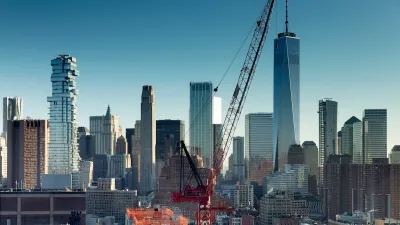An inexpensive architectural style is deemed unfit for a town looking to preserve its history—and become a more sophisticated city.
Supposedly "[a]larmed by a map of demolitions the City Council was to review, "Jersey City Mayor Steve Fulop has imposed a six-month moratorium on the issuing of new demolition permits for "structurally sound" one-to-four unit buildings.
The Jersey Journal reports that the order has "ignited a battle between his administration and local developers," but that "Fulop says he's siding with Heights residents who accuse developers of building homes that destroy the character of neighborhoods."/p>
Or as Fulop put it succinctly in a Twitter post, "We're losing many of our great/old homes + being replaced w/the architectural marvel known as 'The Bayonne Box.'"
The "Bayonne Box" is a vernacular architectural style that dates to the 1990s; it's typically characterized by three stories, usually more than one unit, and a curb cut to facilitate off-street parking.
The boxes were developed as a way to quickly produce inexpensive housing that appealed to those living in it (and still do—one supporter of Fulop's moratorium is the president of a neighborhood association who admits to living in one and liking it) but are inconsistent with a place that is now trying to increase density and discourage car ownership though better transit; Newark made similar efforts a decade ago.
In the next six months, Jersey City plans to review the ordinances that govern preservation and development; currently, for example, a builder cannot cut the curb for an old structure, but can do so if they tear it down and build a new one.
Part of the problem for those opposing Fulop's order is that, like much of the nation, New Jersey has an affordable housing problem, but given its proximity to Manhattan, no shortage of new luxury high-rise apartment buildings. Not many people care to defend to the aesthetic appeal of the Bayonne Box, but a few recognize its continuing appeal.
FULL STORY: Fulop demolition ban targets 'Bayonne boxes' in Jersey City

Study: Maui’s Plan to Convert Vacation Rentals to Long-Term Housing Could Cause Nearly $1 Billion Economic Loss
The plan would reduce visitor accommodation by 25,% resulting in 1,900 jobs lost.

North Texas Transit Leaders Tout Benefits of TOD for Growing Region
At a summit focused on transit-oriented development, policymakers discussed how North Texas’ expanded light rail system can serve as a tool for economic growth.

Why Should We Subsidize Public Transportation?
Many public transit agencies face financial stress due to rising costs, declining fare revenue, and declining subsidies. Transit advocates must provide a strong business case for increasing public transit funding.

How to Make US Trains Faster
Changes to boarding platforms and a switch to electric trains could improve U.S. passenger rail service without the added cost of high-speed rail.

Columbia’s Revitalized ‘Loop’ Is a Hub for Local Entrepreneurs
A focus on small businesses is helping a commercial corridor in Columbia, Missouri thrive.

Invasive Insect Threatens Minnesota’s Ash Forests
The Emerald Ash Borer is a rapidly spreading invasive pest threatening Minnesota’s ash trees, and homeowners are encouraged to plant diverse replacement species, avoid moving ash firewood, and monitor for signs of infestation.
Urban Design for Planners 1: Software Tools
This six-course series explores essential urban design concepts using open source software and equips planners with the tools they need to participate fully in the urban design process.
Planning for Universal Design
Learn the tools for implementing Universal Design in planning regulations.
City of Santa Clarita
Ascent Environmental
Institute for Housing and Urban Development Studies (IHS)
City of Grandview
Harvard GSD Executive Education
Toledo-Lucas County Plan Commissions
Salt Lake City
NYU Wagner Graduate School of Public Service





























